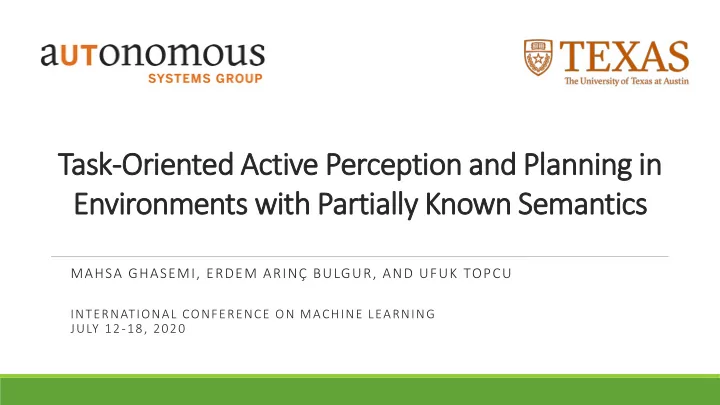

Task-Oriented Active Perception and Planning in Environments with Partially Known Semantics MAHSA GHASEMI, ERDEM ARINÇ BULGUR, AND UFUK TOPCU INTERNATIONAL CONFERENCE ON MACHINE LEARNING JULY 12-18, 2020
Integrating Data into Decision Making Process Setting • Sequential decision making • Partial knowledge of environment • Continual information gathering planning Challenge How to simultaneously perceive and plan perception with efficiency and performance guarantee? Contributions 1. Provide guarantee on task success 2. Characterize information utility 3. Guide active perception while planning 1
Task-Oriented Active Perception and Planning Take one action low Gather Divergence Update belief information test high MAP estimation of state attributes high Go to informative Find an Risk due to Synthesize state “informative state” uncertainty optimal policy low 2
System Dynamics as Markov Decision Process An MDP is a tuple • is a finite discrete state space • is an initial state (c,1) • is a finite discrete action space 𝑡 1 • is a probabilistic transition (b,1) (d,1) function such that for all and for all , (a, 0.7) 𝑡 0 (c,1) Memoryless deterministic policies (a, 0.3) (d,1) 𝑡 2 Induced Markov chain • An MDP • • is such that for all , 4
Environment Model and Observation Model An environment model is a tuple • is a finite discrete state space • is a set of atomic propositions (c,1) 𝑞 ∶ 0.8 • 𝑞 ∶ 1.0 is a true labeling function ¬ 𝑞 ∶ 0.2 𝑡 1 ¬ 𝑞 ∶ 0.0 (b,1) (d,1) (a, 0.7) 𝑡 0 An observation model is a joint probability distribution . (c,1) (a, 0.3) 𝑞 ∶ 0.0 (d,1) 𝑡 2 ¬ 𝑞 ∶ 1.0 Belief at time is a probabilistic labeling function An MDP with such that for all , partial semantics . 5
Task Specification with Linear Temporal Logic • Linear temporal logic (LTL): A formal language with logical and temporal operators ▪ Suitable for high-level task specification ▪ Verifiable ▪ Qualitative (almost surely) ▪ Quantitative (probabilistically) ▪ Close to human language ▪ Formal translation of natural language instructions into LTL specifications [E.g., LTLMoP toolkit by Finucane, Jing and Hadas Kress-Gazit, 2010] 6
Automaton Representation of Task • Task specification as LTL formula (with probabilistic guarantee) or and Do not crash with Do not go to door 2 Do not crash with obstacles until you until you find the key obstacles until you reach door 1 reach door 2 • An LTL formula can be transformed into an automaton ▪ A transition system for a task ▪ Captures task progress ▪ A run ending in the accepting state completes the task An automaton 7
Formal Problem Statement Given Find • An MDP A policy that maximizes the • An environment model with unknown probability of satisfying the task conditioned on the true labeling labeling function function, i.e., • An observation model • A syntactically co-safe LTL task specification 8
Task-Oriented Active Perception and Planning 9
Task-Oriented Active Perception and Planning Perception module receives data sampled according to the observation model 10
Task-Oriented Active Perception and Planning The agent updates its learned model of the environment in a Bayesian approach • Assumption: Atomic propositions are mutually independent • Frequentist update if an observation model unavailable 11
Task-Oriented Active Perception and Planning The agent checks whether its learned model of the environment has significantly changed • Jensen-Shannon divergence • A hyperparameter determining the frequency of replanning The agent estimates the most probable environment configuration • According to the current model of the environment • Maximum a posteriori estimation 12
Task-Oriented Active Perception and Planning The agent synthesizes an optimal policy according to the estimated environment configuration • Generating the product MDP (dynamics + task) • Computing the optimal policy using a linear program 13
Task-Oriented Active Perception and Planning The agent assesses the risk due to the perception uncertainties • Statistical verification of the induced Markov chain • Defining a risk parameter • A hyperparameter determining the willingness of the agent to risk 14
Task-Oriented Active Perception and Planning The agent finds an active perception strategy to reduce its perception uncertainty • Local search over a bounded horizon • Criteria: ▪ Forward and backward reachability ▪ Remaining in the same stage of the task ▪ Reducing task-related uncertainty 15
Drone Navigation in Simulated Urban Environment • AirSim [1] simulation environment • A drone navigating in an urban environment • Task: Reach a flagged building while avoiding collision • Dynamics: Planar motion with constant altitude Depth view Segmented view Drone’s view • Sensing: ▪ Exact localization ▪ 4 RGB cameras with 90° field of view ▪ 4 depth sensing cameras with 90° field of view [1] From https://github.com/microsoft/AirSim 16
Processing Image and Depth Data 17
Simulation Results Navigation with exact knowledge Navigation with the proposed task- of the semantic labeling oriented active perception and planning 18
Conclusion and Future Directions Conclusion: • Studied planning in environments with partially known semantics ▪ Guarantee over task performance ▪ Assessment of risk due to imperfect knowledge • Proposed a task-oriented active perception and planning framework that integrates learning through perception with decision-making under uncertainty Future Directions: • Extending the framework to settings with uncertain or unknown dynamics • Using calibrated neural networks for perception module • Incorporating side knowledge on the correlation between the atomic propositions 19
Thank you! Task-Oriented Active Perception and Planning in Environments with Partially Known Semantics Mahsa Ghasemi, Erdem Arınç Bulgur, and Ufuk Topcu
Recommend
More recommend